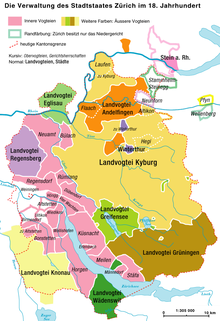Reign of Greifensee

The rule of Greifensee existed between 1300 and 1798. Between 1402 and 1798 it was a bailiff owned by the city of Zurich .
The Greifensee rule came into being in 1300, when Elisabeth von Rapperswil pledged the area from the sphere of control of the Counts of Rapperswil to Hermann II von Landenberg . The Landenberg family sold the pledge in 1369 for 7,923 guilders to the Counts of Toggenburg. Count Friedrich VII of Toggenburg pledged Greifensee in 1402 for 6,000 guilders to the city of Zurich.
The city of Zurich administered the rule of Greifensee as the so-called "Äussere Vogtei". A bailiff resided at Greifensee Castle and exercised the rulership rights on behalf of Zurich. The best-known bailiff of Greifensee was Salomon Landolt , who administered the rule in the spirit of enlightened absolutism .
The rule of Greifensee consisted of the following areas:
- Greifensee castle and town
- The Greifensee (fishing rights)
- Fällanden
- Maur
- Niederuster
- Uster
- Nossikon
- Nanikon
- Werrikon
- Schwerzenbach
- Hegnau
- Hof (municipality of Egg ZH )
- Bertschikon (municipality of Gossau ZH )
- Exclaves: Robenhausen-Robank (municipality of Wetzikon ), Irgenhausen , Auslikon , Hutzikon-Tössegg-Schalchen (municipality of Turbenthal ) and Neubrunn (municipality of Turbenthal)
With the dissolution of the old order in the territory of the city of Zurich, the Landvogtei Greifensee was dissolved in 1798. Today's Uster district roughly corresponds to the Landvogtei Greifesee.
See also : Territorial Development of Zurich , History of the City of Zurich
Web links
- Bruno Schmid: Greifensee (rule, bailiwick). In: Historical Lexicon of Switzerland .
